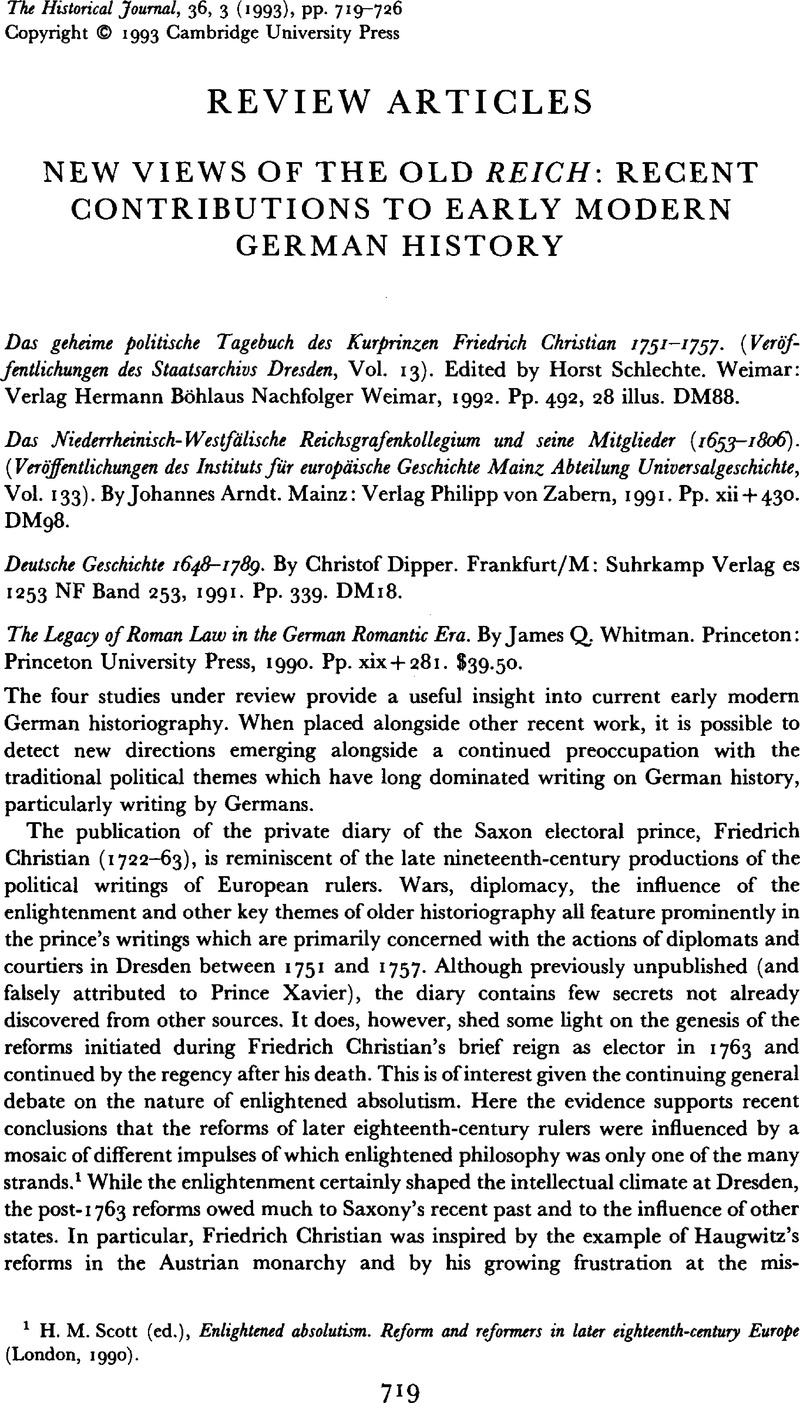No CrossRef data available.
Article contents
New views of the old Reich: Recent Contributions to Early Modern German History
Published online by Cambridge University Press: 11 February 2009
Abstract

- Type
- Review Articles
- Information
- Copyright
- Copyright © Cambridge University Press 1993
References
1 Scott, H. M. (ed.), Enlightened absolutism. Reform and reformers in later eighteenth-century Europe (London, 1990)Google Scholar.
2 For introductions into this growing literature see Schmidt, G. (ed.), Stände und Gesellschaft im Alien Reich (Stuttgart, 1989)Google Scholar and Vann, J. A., ‘New directions for the study of the old Reich’, Journal of Modern History, LVIII (1986), Supplement, pp. 3–22CrossRefGoogle Scholar.
3 Böhme, E., Das fränkische Reichsgrafenkollegium im 16. und 17. Jahrhundert. Untersuchungen zu den Möglichkeiten und Grenzen der korporativen Politik mindermächtiger Reichsstände (Stuttgart, 1989)Google Scholar; Reden-Dohna, A. v, ‘Problems of small estates of the Empire: the example of the Swabian imperial prelates’, Journal of Modern History, LVIII (1986), Supplement, pp. 76–87CrossRefGoogle Scholar; Schulz, T., Der Kanton Kocher der Schwäbtschen Reichsritterschaft 1542–1805 (Esslingen, 1986)Google Scholar.
4 Hughes, M., Early Modern Germany 1477–1806 (London, 1992), p. xiGoogle Scholar.
5 , R. Graf v. Neipperg, , Kaiser und Schwäbischer Kreis (1714–1733). Ein Beitrag zu Reichsverfassung, Kreisgeschichte und Kaiserlicher Reichspolitik am Anfang des 18. Jahrhunderts. (Veröffentlichungen der Kommissim für Geschichtliche Landeskunde in Baden-Württemberg(B, Reihe, Vol. 119) (Stuttgart, 1991)Google Scholar; G. Haug-Moritz, Württembergischer Ständekonflikt und deutscher Dualismus. Ein Beitrag zur Geschichte des Reichsverbands in der Mitte des 18. Jahrhunderts (ibid. vol. 122) (Stuttgart, 1992).
6 For example, Neipperg, Kaiser und Schwabischer Kreis, is particularly critical of James Allen Vann's emphasis on a Swabian spirit of co-operation in hisThe Swabian Kreis. Institutional growth in the Holy Roman Empire, 1648–1715 (Brussels, 1975)Google Scholar.
7 Sheehan, J., German history 1770–1866 (Oxford, 1989)Google Scholar; Wehler, H.-U., Deutsche Gesellschaftsgeschichte 1700–1815 (Munich, 1987)Google Scholar.
8 Ibid. pp. 347–546.
9 Press, V., ‘Die kaiserliche Stellung im Reich zwischen 1648 und 1740 – Versuch einer Neubewertung’, in Schmidt, (ed.), Stände und Geselleschaft, pp. 51–80Google Scholar; Hughes, , Early modern Germany, pp. 122–38Google Scholar; Duchhardt, H., Altes Reich und europäische Staatenwelt 1648–1806 (Munich, 1990). pp. 6–33CrossRefGoogle Scholar.
10 Borck, H.-G., Der sckwäbische Reichskreis im Zeitalter der französischen Revolutionskriege (Stuttgart, 1970)Google Scholar.
11 Wunder, B., Privilegierung und Disziplinierung: Die Entstehung des berufsbeamtcntums in Bayern und Württemberg 1780–1825 (Munich, 1978)Google Scholar.




